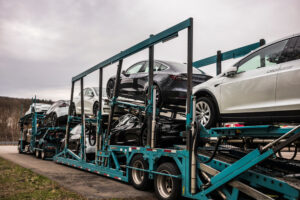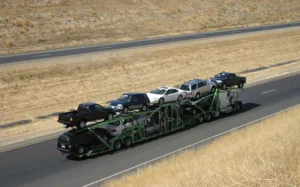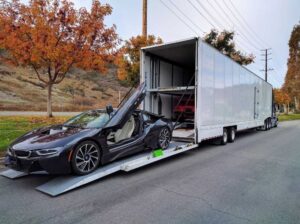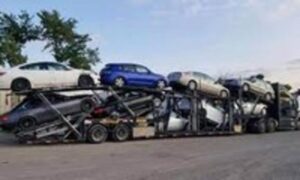Category Archives: Vehicle Shipping
How do you move across the country with multiple cars?
When moving across the country with multiple vehicles, one of the most important things to do in preparation is to plan your route and estimated travel dates Vehicle Shipping. Decide where you will stop along the way for rest, food, sightseeing, and to switch drivers. Here are some tips for planning the route:
- Research driving times between major cities along your route. Account for stops and variable factors like weather. Build in buffer time.
- Plan to drive 8-10 hours per day maximum. Longer drives increase fatigue risks Vehicle Shipping.
- Choose scenic and interesting stopping points along the way for short breaks, sightseeing or overnight stays. National and state parks can offer beautiful areas to pause.
- Consider drive times for work/school commitments or events like moving help availability at the new location when setting your travel window.
- Map out gas stations, rest areas and reliable overnight accommodations along your route in case plans change.
- Download maps and directions for offline use in remote areas with spotty cell service.
Pack Appropriately for Passengers and Cargo
With two or more vehicles to load, organizing everything efficiently will be key. Here are packing tips:
- Use packing paper, blankets or protective wraps to cushion fragile items from bouncing around during travel.
- Secure heavier items low and centered for best vehicle balance and control. Don’t overload cargo areas.
- Pack a “road trip kit” with snacks, water, medication, toys/books for kids in each car for easy access Vehicle Shipping.
- Include car repair essentials like a jack, spare tire, jumper cables and emergency flashers in each vehicle.
- Label boxes clearly by room of destination to streamline unloading. Create a box inventory for reference.
- Consider renting a small trailer or U-Haul for extra cargo space if needed. Be sure vehicles can tow safely Vehicle Shipping.
Prepare Your Vehicles
Completing pre-move maintenance and inspections on all cars is vital for safety and avoiding breakdowns along the way. Here are key vehicle prep tips:
- Check fluid levels, tire tread and pressure, lights, signals, wipers and battery. Replace as needed.
- Rotate tires and replace if over 5 years old to reduce wear issues on a long trip.
- Schedule major maintenance like tune-ups, brakes and fluid exchanges if service is due within 500 miles of travel.
- Ensure spare tire, lug wrench and jack are in each vehicle. Consider installing an inflator kit too.
- Pack safety gear like flares, emergency flashers, first aid kit, masks, disinfecting wipes.
- Carry motor club memberships or breakdown policies for quicker assistance if problems arise Vehicle Shipping.
Document And Communicate Plans
Keeping loved ones updated and having key documents with you provides safety and ease of mind on your journey. Consider:
- Notifying friends/family of your planned route, stops and estimated arrival dates if traveling alone.
- Carrying copies of licenses, registration and insurance for each vehicle separately for reference at stops.
- Downloading GPS tracking apps to share in real-time where multiple vehicles are along the route with each other.
- Storing important phone numbers like mechanics, services and emergency contacts in an easy to access physical or digital list.
The Big Drive
With preparations complete, it’s time to hit the open road! Here are tips for smooth sailing whether traveling together or separately in convoy style.
Maintain Communication
If traveling separately in multiple vehicles, staying in touch becomes even more important for coordinating fuel/rest stop meetups, addressing any vehicle issues and rerouting as needed.
- Use phone calls, texts and GPS sharing apps frequently to report your location and expected arrival times at stops.
- Check in every 2-3 hours minimum, more often in inclement weather or heavy traffic areas. Don’t leave long gaps unaccounted for.
- Decide on a lead vehicle that shares route planning updates with the group if changes are required due to construction, weather or other factors.
- Designate rest stop meetup spots along the route in advance so no one gets left behind.
Monitor Yourself And Other Drivers
Driving long distances over multiple days takes stamina. Be mindful of how others in your party might be faring too.
- Switch drivers every 2-4 hours to offset fatigue, especially on multi-day drives. Pull over for additional short breaks if drowsy signs appear.
- Stay hydrated, eat snacks regularly and use rest stops for stretching, fresh air and to replenish energy. Caffeine has limits so use judiciously.
- Watch fellow drivers for wandering, slow reactions or drifting within their lane which can indicate fatigue. Offer to switch or take an additional break.
- Consider alternate entertainment like books on tape, podcasts or guided relaxation to engage minds during monotonous highway miles and help stave off boredom or restlessness.
Minimize Drive Time Distractions
While on the road, focus on the task of safety operating your vehicle – no distractions!
- Silence phones (or use do not disturb mode) and stash away unless an emergency arises. No endless scrolling!
- Designate one navigation/music device accessed by passenger only to avoid driver distraction.
- Avoid roadside impulse purchases or unplanned lengthy stops to keep moving at a good pace.
- Plan to enjoy new surroundings and experiences once safely parked for the day rather than endangering others by multitasking at the wheel.
Adjust Plans As Needed
Be flexible and willing to modify your route in real-time as unexpected delays, closures or weather affect timelines.
- Check local traffic and highway authority alerts frequently, especially through construction zones for estimated length of backups.
- Consider alternate routes to bypass multi-hour traffic jams shown on GPS. Take rest stops earlier if delays occur.
- If storms, flooding or other conditions worsen driving safety significantly, be prepared to stop driving earlier than planned or take an unscheduled rest day.
- Communicate changes to estimated arrival times and meetup locations promptly with any others in your party when altering the itinerary.
Arrival And Unloading
After days of travel, bask in the sense of accomplishment upon reaching your destination! Here are final guidance points:
- Plan celebratory meals together and adequate rest before tackling unloading projects if arrival timing allows.
- Designate parking areas and organize a unloading workflow in advance with helpers.
- Clearly label boxes again by room when stacking to streamline putting items away appropriately.
- Consider renting storage pods for temporary consolidation of items if space is limited until moving fully in.
- Secure valuables promptly like ID, documents and electronics to prevent theft during transition times.
- Enjoy connecting with family and friends in your new community once settled with a first look around your fresh surroundings! Safe travels and best wishes in your new home.
Conclusion
With thorough pre-trip planning and focusing on safety, communication and flexibility along the way, moving across the country with multiple vehicles becomes very manageable. Be sure to account for variables and avoid risks by adhering to a sensible pace without rushing. Most importantly though, enjoy the adventure of journeying to new horizons together – the memories formed will last for years to come! With a positive attitude and teamwork approach, you’ve got this!











